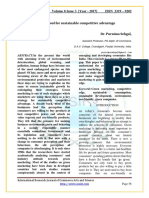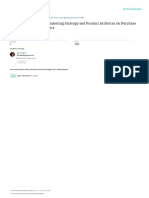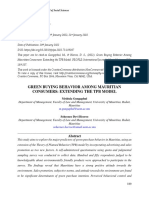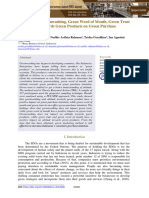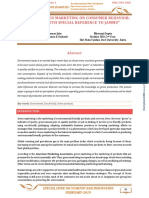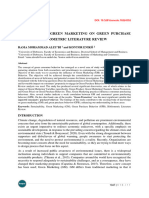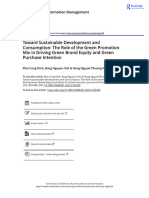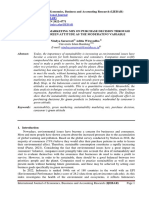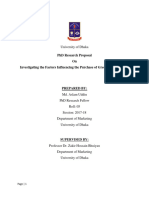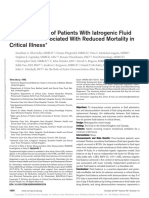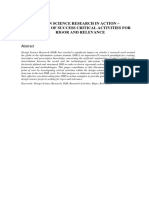Professional Documents
Culture Documents
Do Green Marketing Strategies Influence Green Buying Intentions Evidence From Developing Economy
Copyright
Available Formats
Share this document
Did you find this document useful?
Is this content inappropriate?
Report this DocumentCopyright:
Available Formats
Do Green Marketing Strategies Influence Green Buying Intentions Evidence From Developing Economy
Copyright:
Available Formats
Volume 7, Issue 10, October – 2022 International Journal of Innovative Science and Research Technology
ISSN No:-2456-2165
Do Green Marketing Strategies Influence Green
Buying Intentions? Evidence from
Developing Economy
Amena Khatuna Sanjoy Kumar Royb*
Lecturer, Department of Business Administration, Corresponding author, Assistant Professor,
European University of Bangladesh, General Education Department, City University,
Dhaka, Bangladesh, Dhaka, Bangladesh
Abstract:- This study aimsto investigate the influence of green design, production, integrated marketing
green marketing strategies on the green buying communication, etc. (Saleem et al., 2021).
intentions of Bangladeshi green consumers. A
convenience sample of 277 consumers was used. The For a few years, the environment has been facing
study employed structural equation modeling to several challenges, such as global warming, air pollution,
scrutinize the impact of green marketing strategies. The water pollution, climate change, etc., which have led
results indicate that all the green variables (value, consumers to be more aware of the consequences of these
packaging, labeling, price place, and promotion) challenges (Govender and Govender, 2016). These
significantly impact green buying intentions.The green challenges have prioritized the business atmosphere and
promotion has the highest impact and the green place public thinking (Govender and Govender, 2016). Once,
has the lowest impact on the green buying intentions of quality of life, sustainability, society's well-being, the
consumers. Marketers and experts may take necessary cohesion of society, and transmission of values were just in
steps for the betterment of business marketing as well as morality, but nowadays, these are the norms in business
for a sustainable environment and livelihood. ethics for the sake of the society, environment, and
organization (Murin et al., 2015; Islam et al., 2021). By
Keywords:- green strategy, green buying intention; green applying green marketing, marketers can bring betterment
consumer behavior; green marketing, Bangladesh. for our planet and inspire the public who are conscious of
the consequence of the challenges the environment is facing
I. INTRODUCTION today. Again, by giving importance to sustainable green
products,companies can decrease damageto our
An environment surrounds us, and this environment is environment. That's why green marketing is also called eco-
being negatively affected by human activities (Vani, 2022). marketing or environmental marketing (Machova et al.,
Every government worldwide is trying to reduce its 2022). Green marketing makes the marketer capable of
influence on the environment (Vani,2022). Nowadays, occupying a distinctive position in the consumers' mindset,
people are more concerned with the environment than increasing the number of loyal customers. As a result, the
before (Vani, 2022). Due to the new concern of society, marketer gets a higher competitive advantage in the
marketers have started to modify their business activities marketplace. Marketers who adopt green marketing
and integrate environmental aspects into business activities strategies can minimize the negative impact of
(Vani, 2022). Green issues have been incorporated manufacturing on the environment. They can manufacture
intovarious literature by academic disciplines, for example, recyclable products, decrease the consumption of energy,
marketing(Kaur et al., 2022; Vani,2022), human resource decrease the utilization of natural resources, increase
management (Chowdhury et al., 2019; credibility, accomplish innovation,confirmlongitudinal
Tanova&Bayighomog, 2022), education (Zhong et al., growth and earn higher revenue.
2022). "Green Marketing" is included in the syllabus, and
along with marketing, students study green marketing There are severalpieces of research where the
(Vani,2022). Green marketing develops and sells goods and researchers have narrated the influence of green marketing
services which are environmentally friendly. Green strategies on purchasing intention and consumer behavior in
marketing incorporates marketing strategies in a way that several nations (Hossain and Rahman, 2018; Kaur et al.,
considers society's long-term interests and is connected to 2022; Mehraj& Qureshi, 2020).Since Bangladesh is the
the companies, consumers, and environment (Karnai et al., eighth most populated country in the world, more research is
2021). Green marketing considers sustainable designs, tools needed on green marketing issues to protect the country's
and environmentally friendly strategies to fulfil consumers' ecology from ecological hazards (Hossain and Rahman,
needs (Chowdhury & Roy, 2015; Mohammed, 2021; 2018; Kaur et al., 2022). There is inadequatework on the
Machovaet al., 2022). Marketing should not be defined as effect of green marketing strategies adopted by marketers to
only sales and advertisements; a wide range of activities are satisfy green consumers in Bangladesh(Hossain and
included in it, for example, product ideation, distribution, Rahman, 2018). Previous studies especially measure the
packaging, transportation, promotion, pricing, etc. (Saleem impact of a green marketing mix on green consumer buying
et al., 2021). Green marketing includes a wide range of intentions (Hossain and Rahman, 2018; Kaur et al., 2022;
environment-oriented marketing activities, for example, Roy et al., 2021). The marketing mix variables were the
IJISRT22OCT802 www.ijisrt.com 766
Volume 7, Issue 10, October – 2022 International Journal of Innovative Science and Research Technology
ISSN No:-2456-2165
green product, green price, green place and green and avoid purchasing plastic-packaged products. Therefore,
promotion. But the green product variable comprises three marketers should try not to sell plastic packaged products
factors: green value, green packaging, and green labelling. and emphasize recycled packaging because consumers'
Again, no work has been done to investigate the significant green purchasing decision is greatly influenced by green
impact of green value, green packaging, and green labelling packaging (Agyeman, 2014). According to Davis (2014),
on green buying intentions in the context of Bangladesh. female consumers prioritize packaging more than males.
Therefore, this study has been designed to fill up the Hence, green packaging attracts and encourages green
gap.This study aims to scrutinize the impact of green purchasing (Jerda&Sahayaselvi, 2018).So, the hypothesis is:
marketing strategy variables on consumers' buying intention
in the context of Bangladesh. H2: Green packaging significantly influences consumers'
green buying intentions.
A. Green Consumer
Green marketers are those who purchase green products C. Green Labeling
(Vani, 2022). Green consumers' purpose is to save Green labels are the symbols used to describe a product
themselves the globe through their purchasing power as environmentally safe, and the product is considered a
(Zeynalova&Namazova, 2022). All purchasing activities of green product (Sharma and Kushwaha 2019). Green labels
green consumers are based on the intention to ensure the are considered in terms of environmental standards (Sharma
ecological balance (Vani, 2022). By avoiding buying and Kushwaha 2019). Green label is considered an
products that are detrimental to the environment, green important medium of communication that conveys
consumers contribute greatly to the environment (Vani, information to consumers and helps them to take purchasing
2022). Green consumers do not buy unwholesome products; decision (Rex and Baumann, 2007). Since green labeling is
detrimental to the environment during production, usage, the appearance of an environment-friendly product, most
and after usage; they do not consume more energyand consumers like green-labeled products compared tothe
elements that endanger different species(Vani, 2022). traditional labeled product (Sharma and Kushwaha 2019).
Therefore, a green consumer adopts environmentally So, green labeling increases sales, and the hypothesis is:
friendly behaviours and purchases green products (Vani,
2022). H3: Green labeling significantly influences consumers'
green buying intentions.
II. LITERATURE REVIEW
D. Green Pricing
A. Green Value An individual has to pay an amount to obtain ownership
Value is the difference between the benefits of of something; this amount is called a price (Burrow,
preserving and consuming a product and the cost of 2008).Marketers should emphasize green pricing since it is
obtaining that product. Green products meet consumer needs one of the important elements of the green marketing mix
in a way that involves environmental well-being (Patterson (Govender & Govender, 2016). Price is the prime reason
and Spreng, 1997). Previous researchers proved that green consumers do not purchase a green product because of its
value is an important element of green marketing strategies, expense (Bukhari, 2011).However,consumers are frequently
which influences green consumers' buying intention. purchasing green products today (Ahammad,2012).
Therefore, marketers emphasize green value perception Especially, the young generation is more interested in
because it enhances consumer purchasing interest purchasing green products and paying a fixed amount
(Steenkamp and Geyskens, 2006). When consumers (Anvar& Venter, 2014). Green products or services,
perceive increased value from a product, their purchasing recyclable paper, brand-new coffee strainer, and renewable
intention increases for this product (Chang & Chen, energy facility creates the floor for green pricing
2008).Perceived green value and buying intention are highly (Ahammad, 2012). Different costs incorporated because of
correlated (Dhewi et al., 2018). Perceived value greatly the consideration of environmental standards are added to
influences increasing sales (Dhewi et al., 2018). So, the green products' production costs (Kaur et al., 2022). When
hypothesis is: consumers perceive that the consumed benefit exceeds the
cost, they are willing to pay the price fixed by the marketer
H1: Green value significantly influences consumers' (Abzari et al.,2013). Therefore, green product prices
green buying intentions. significantly affect buying intention (Widayanti,
2020).Previous researches show that consumers of green
B. Green Packaging product are not reluctant to pay a higher price forgreen
Green packaging is served as the marketing strategy to products (Bathmathan&Rajadurai, 2019).Therefore, the
contain, identify, explain, protect, visualize, communicate hypothesis is:
and make the green product marketable (Govender &
Govender, 2016). Green packaging is designed and H4: Green price significantly influences consumers'
produced insuch a way it is beneficial to the users, green buying intentions.
consumers, and manufacturers of packaged products (Kozik,
2020). In recent years, packaging has been designed and
produced in terms of environmental aspects (Kozik, 2020).
One of the main reasons for environmental pollution is the
usage of plastic. Consumers are more environment-oriented
IJISRT22OCT802 www.ijisrt.com 767
Volume 7, Issue 10, October – 2022 International Journal of Innovative Science and Research Technology
ISSN No:-2456-2165
E. Green Place environment faces today and purchase eco-friendly goods
The place consists of the firms and people who make a that are biodegradable, produced with recycled materials,
product available to the consumers. The closer location and and CFC-free. Advertising effectively increases customers'
easy accessibility impact consumer buying decisions since knowledge about a product and its influence on the
most consumers are not interested in buying green products environment (Ansar, 2013). Nowadays, emotional
or services by travelling far (Kontic, 2010). Green products advertising is the priorityfor marketers to influence the
can be available for consumers in supermarkets (Gittell et buying intention of consumers (Ahern, 2013). So, marketers
al., 2015).Hence, marketers should give importance to the can use environmental advertising to increase the motivation
availability of green products in the nearest place to the of consumers to purchase green products. (Govender &
consumer (Kaur et al., 2022). Therefore, the hypothesis is: Govender, 2016).Previous studies show that green
promotion has been able to modify green consumers'
H5: Green place significantly influences consumers' traditional purchasing habits, and the habits have been
green buying intentions. shifted to green products (Agus&Rasmen, 2019).If
marketers implement these promotional strategies properly,
F. Green Promotion consumers will be attracted to green products, increasing
Green promotion introduces a green product in the green purchasing.Therefore, the hypothesis is:
marketplace and persuades green consumers to purchase that
product. When consumers are not knowledgeable enough H6: Green promotionimportantly influences consumers'
about a product, visual presentation in the product's green buying intentions.
packaging is an important tool for marketing promotion
(Govender & Govender, 2016). The green promotion also The proposed hypothesized model is represented in figure 1.
works to create consciousness of the hazards the
Green value
Green Packaging
Green Labeling
Green
Buying
Green Price Intention
Green Place
Green Promotion
Fig. 1: Hypothesized Research Model
IJISRT22OCT802 www.ijisrt.com 768
Volume 7, Issue 10, October – 2022 International Journal of Innovative Science and Research Technology
ISSN No:-2456-2165
III. METHODOTHOLOGY statements relating to the dependent variable, green buying
intention. The items are given in appendix 1. A total of 300
A. Data Collection respondents were given the questionnaire to fill up. After
For collecting primary data, a personal interview final checking, 277 questionnaire was suitable for further
technique was employed. Convenience sampling methods analysis. The analysis was performed by using SPSS and
have been used for collecting information from customers SmartPLS software.
who are well known for the term "green marketing". All the
constructs from the literature were with standard scales. B. Consumers demographic analysis
Since a structured questionnaire makes it easier to answer 53.07% of the consumers were female, and the rest were
the questions, a well-structured questionnaire has been male. Most consumers are 20-25 years (45.49%) and are
formulated by the researchers (Roy & Ahmed, 2016). For graduates (39.71%). Furthermore, the majority of green
collecting the consumer responses,a five-pointLikert scale consumers are students (37.54%). Only 8.30% of the
was used. In this study, onepresented"strongly disagree", respondents have an income of more than 50000
and five presented"strongly agree". In the dimensions of Bangladeshi taka, whereas less than 30000 Bangladeshi taka
green marketing strategies, researchers have used 22 (46.21%) (See Table 1).
statements for ratingsof the performance. There were four
Male Female Total
20-25 52 (40%) 74 (50.34%) 126 (45.49%)
26-30 28 (21.54%) 24 (16.33%) 52 (18.77%)
Age 31-35 47 (36.15%) 43 (29.25%) 90 (32.49%)
36-40 3 (2.31%) 6 (4.08%) 9 (3.25%)
130 (46.93%) 147 (53.07%) 277 (100%)
Undergraduate 24 (18.46%) 62 (42.18%) 86 (31.05%)
Graduate 40 (30.77%) 70 (47.62%) 110 (39.71%)
Education Post-graduate 60 (46.15%) 11 (7.48%) 71 (25.63%)
Doctorate 6 (4.62%) 4 (2.72%) 10 (3.61%)
130 (46.93%) 147 (53.07%) 277 (100%)
Student 42 (32.31%) 62 (42.18%) 104 (37.54%)
Homemaker 1 (0.77%) 54 (36.73%) 55 (19.86%)
Occupation Own business 22 (16.92%) 20 (13.61%) 42 (15.16%)
Professional 65 (50%) 11 (7.48%) 76 (27.44%)
130 (46.93%) 147 (53.07%) 277 (100%)
Less than 30,000 48 (36.92%) 80 (54.42%) 128 (46.21%)
Monthly Income 30,000-50,000 66 (50.77%) 60 (40.82%) 126 (45.49%)
More than 50,000 16 (12.31%) 7 (4.76%) 23 (8.30%)
130 (46.93%) 147 (53.07%) 277 (100%)
Table 1: Demographic profile of the respondents
IV. RESULTS values varied from 0.743 to 0.877, which was greater than
the 0.70 indicated by Nunnally and Bernstein (1994). The
A. Assessment of the measurement model CR values of all latent constructs varied from 0.837 to
To assess the measurement model, researchers check the 0.924, which was much higher than the tolerable limit of
factor loadings (λ), Cronbach's alpha (α), composite 0.70 (Hair et al., 2020). Furthermore, the AVE values were
reliability (CR), average variance extracted (AVE), and greater than the cutoff value of 0.50 (Hair et al., 2010) for
discriminant validity (Hair et al., 2020; Roy, 2022). The all the constructs. Based on these fit indicators, it was
result found that the λ values for all variables were ensured that the model had appropriate convergent validity.
substantial and greater than the indicated threshold value of
0.70 (Hair et al., 2020). See table 2 and figure 2.
Furthermore, the findings of construct consistency using α
IJISRT22OCT802 www.ijisrt.com 769
Volume 7, Issue 10, October – 2022 International Journal of Innovative Science and Research Technology
ISSN No:-2456-2165
Factor Items λ α CR AVE
Green Value GVAL1 0.725 0.828 0.879 0.593
GVAL2 0.803
GVAL3 0.754
GVAL4 0.765
GVAL5 0.801
Green Packaging GPAC1 0.824 0.743 0.837 0.562
GPAC2 0.706
GPAC3 0.715
GPAC4 0.749
Green Labeling GLAB1 0.848 0.777 0.870 0.691
GLAB2 0.796
GLAB3 0.849
Green Price GPRI1 0.799 0.834 0.889 0.667
GPRI2 0.877
GPRI3 0.733
GPRI4 0.850
Green Place GPLA1 0.921 0.877 0.924 0.802
GPLA2 0.884
GPLA3 0.881
Green Promotion GPRO1 0.850 0.820 0.892 0.734
GPRO2 0.866
GPRO3 0.853
Green Buying Intention GBIN1 0.876 0.861 0.905 0.705
GBIN2 0.855
GBIN3 0.821
GBIN4 0.804
Table 2: Convergent validity
Again, to measure the discriminant validity of the the AVE values. The study results meet these conditions.
model, Fornell&Larcker's (1981) criteria and Heterotrait- Again, the HTMT ratio value needs to be less than the
Monotrait ratio (HTMT) were employed. According threshold of 0.85 (Kline, 2015). The outcomes of the work
toFornell and Larcker's criteria, the inter-correlation affirm the criteria. So, the discriminant validity has no
between the construct must be less than the square root of issues. See Table 3.
Fornell and Larcker's criteria
Green Green Green Green Green Green Green Buying
Value Packaging Labeling Price Place Promotion Intention
Green Value 0.770
Green Packaging 0.562 0.750
Green Labeling 0.651 0.470 0.832
Green Price 0.638 0.472 0.674 0.817
Green Place 0.568 0.504 0.513 0.533 0.896
Green Promotion 0.567 0.485 0.598 0.666 0.599 0.857
Green Buying 0.671 0.580 0.653 0.669 0.597 0.659 0.839
Intention
HTMT ratio
Green Value
Green Packaging 0.710
Green Labeling 0.814 0.610
Green Price 0.760 0.578 0.840
Green Place 0.666 0.606 0.620 0.621
Green Promotion 0.678 0.598 0.739 0.786 0.698
Green Buying 0.780 0.705 0.791 0.766 0.678 0.768
Intention
Note: Bold diagonal elements represent the square root of AVE values.
Table 3: Discriminant validity
IJISRT22OCT802 www.ijisrt.com 770
Volume 7, Issue 10, October – 2022 International Journal of Innovative Science and Research Technology
ISSN No:-2456-2165
Fig. 2: The results of the measurement model
B. Structural equation model (SEM) buying intention. The results support the hypothesis (β
The study then proceeds by examining the structural =0.163, t-value = 2.846, p-value <0.01).The outcome is
model's path coefficients, illustrated in table 4 and figure 03. analogous to the previous work (Rex and Baumann, 2007).
As for hypothesis, H1, the green value has a significant Again, as stated by H4, the green price significantly impacts
impact on green buying intention(β =0.187, t-value = 2.841, green buying intention. Hypothesis H4 is supported by the
p-value <0.01). The hypothesis was supported, which study results (β =0.173, t-value = 2.493, p-value <0.05) and
confirms that the green value significantly positively is also similar to the work of Widayanti(2020). Similarly,
impactsgreen buying intention. The study outcomes were green place significantly predicts green buying intention (β
supported by earlier research (Chang & Chen, 2008; Dhewi =0.118, t-value = 2.467, p-value <0.05) and supports the
et al., 2018). The result found that green packaging is a hypothesis H5. The result is identical toKaur et al.'s
substantial predictor of green buying intention because β result(2022). Finally, green promotion is also an important
=0.165, t-value = 2.904, and p-value <0.01. So, hypothesis predictor of green buying intention. The study results
H2 was supported, and the result is consistent with supported the preposition H6(β=0.190, t-value = 3.154, p-
Jerda&Sahayaselvi's (2018) research work.According to value <0.01) and consistent with the earlier research work
hypothesis H3, green labeling significantly impacts green (Ahern, 2013; Agus&Rasmen, 2019).
IJISRT22OCT802 www.ijisrt.com 771
Volume 7, Issue 10, October – 2022 International Journal of Innovative Science and Research Technology
ISSN No:-2456-2165
Fig. 3: The results of the structural model
H Relationships β t-values p-values Supported
H1 Green Value -> Green Buying Intention 0.187 2.841 0.005 Yes
H2 Green Packaging -> Green Buying Intention 0.165 2.904 0.004 Yes
H3 Green Labeling -> Green Buying Intention 0.163 2.846 0.004 Yes
H4 Green Price -> Green Buying Intention 0.173 2.493 0.013 Yes
H5 Green Place -> Green Buying Intention 0.118 2.467 0.014 Yes
H6 Green Promotion -> Green Buying Intention 0.190 3.154 0.002 Yes
Table 4: Structural Equation Model (SEM) with Results
C. Predictive power (R2) and predictive relevance (Q2) V. DISCUSSION
The quality of the structural model was evaluated by the
coefficient of determination (R2) and predictive relevance This research has been conducted for the purpose of
(Q2). The model has substantial explanatory power as green describing the influence of green marketing mix essentials
value, packaging, labeling, price, place, and promotion on the buying intention of the green consumer of
explain 63.9% of the variance in brand trust. Again, the Bangladesh after the pandemic period of Covid-19. Hence,
predictive relevance value was .435, which is greater than 0, it is a must for the producer and marketer to perceive the
indicating good predictive relevance (Chin et al., 2020). The relevancy of the strategies of the marketing mix for
researchers also checked the goodness of fit (GoF) index. attracting the green consumer towards green products
The approximate fit of the structural model was assessed by produced and sold. The researchers have perceived that all
standardized root mean square residuals (SRMR) (Henseler, the elements of green marketing considered by the
2012). For a good fit of a model, the SRMR value should commercial organization positively impact the purchasing
the less than 0.08 (Henseler, 2012). The SRMR value of the decision of Bangladeshi green consumers towards pro-
study was 0.067, which indicates considerable goodness of environmental products. The findings show that Bangladeshi
fit. consumers' purchasing intention is significantly impacted by
green value, packaging, labelling, price, place, and
IJISRT22OCT802 www.ijisrt.com 772
Volume 7, Issue 10, October – 2022 International Journal of Innovative Science and Research Technology
ISSN No:-2456-2165
promotion. This way, it can be narrated that a green product place, and green promotion) will empirically accomplish the
is eco-friendly. A green product's quality is high, it is purchasing intention of Bangladeshi people. This study has
beneficial to health, and the cost of a green product is contributed to the literature by suggesting a structural
justified. So, most of the respondents perceive that the equation model with necessary constructs to reveal the green
benefit of the green product outweighs the cost, and the buying decision of the green consumers of Bangladesh. The
perceived value significantly influence consumers' buying finding of exploratory research plays a significant role in
decision. Secondly, the aesthetic design or patterns building up the theory around green marketing elements and
motivates consumers' buying action. Green packaging is consumers' intentions. Bangladeshi consumers' purchasing
considered a means of pride and possession by green intentions are significantly influenced by green value, green
consumers. Some consumers do not observe the production packaging, green labeling, green price, green place and
and expiry date. Some are very concerned about labeling green promotion. Hence, the researchers suggest this study
green products, which influences their purchasing will encourage the marketers of green products to apply
intentions. The green product's price is reasonable to the oppressive strategies related to green value, green
consumers. The price of the green product is proportionate packaging, green labeling, green labeling, green price,
with its quality and other green aspects. Green products environment-friendly place and green promotion mixes. So,
consumers want green products easily accessible in the it is high time to design a new marketing campaign
green retail store. Green consumers know about the involving a consumer's necessity to consume a green
environmental benefits of green products through different product and contribute to saving the earth from further
promotional mixes that make them easily acceptable. downfall.
It is also emphasized that green places/channels had VII. CONCLUSIONS, LIMITATIONS, AND FUTURE
the lowest, and green promotion had the greatest influence RESEARCH
on green purchasing intention. This states that Bangladeshi
customers are encouraged by the green marketing offerings There is an increased demand for green products from
of the seller and convert their green purchasing intention the emergence of environmental protection, safety and
into actual purchasing. It is also highlighted that the green health of families. More experiments are needed to justify
consumers' trust in the offerings of the green seller is more the theoretical components that reveal the deepness of the
important than the perception of the green product as the categorical greenness of customers' purchasing intentions.
solution to environmental hazards. On the other hand, Environmental attitude is a concept which is growing
previous research proved that green product is the most rapidly with consumer buying intention habits in
significant factor influencing on green purchasing intention Bangladesh. On the contrary, the upcoming scope of the
of Bangladeshi customers (Hossain & Rahman, 2018). In research related to the 4Ps of marketing can require more
contrast, green products have less significance on the and various measures, e. g.,the 7Ps (product, price, place,
purchasing intention of Indian customers (Kaur et al., 2022). promotion, packaging, positioning and people) of the green
marketing strategies in Bangladesh. In the case of
VI. THEORETICAL AND PRACTICAL IMPLICATION maintaining a greener and cleaner environment, buyers are
not reluctant to pay more for green promotions. So, green
By this exploratory research, the green marketing mix advertising play's vital role in agricultural countries like
strategies have been affirmed as the significant predictors of India for buying intentions. The organizations that are
green purchasing decisions of the consumers of Bangladesh, improving with creative objects, resources and newness,
which will vitally contribute to the literature. Hence, saving the ecology and describing the task assimilate the
policymakers and marketers should design marketing tools conclusions will get the maximum benefits in future.
and tactics to incorporate the customer's positive ecological
attitude into purchasing intention for green goods or This study cannot overcome four limitations: Firstly, a
services. To convert the buying decision of the green cross-sectional design has been used, determining the
consumer into the green buying decision, a marketer should practical value of the findings for the producers and
dominate the environmental emotions of the consumer. marketers. Secondly, this exploratory analysis does not
Ecology-sensitive customers are mainly involved in the generalize Western and developed nations since this study
move. In addition, emerging countries' consumers like has been conducted in an economy that assimilates unique
Bangladesh are likely to be nature-oriented; hence, this cultural characteristics completely different from developed
nature orientation can be considered the floor by marketers nations. Thirdly, random sampling may be used since the
to plan their future movements strategically. present study only uses a convenience sampling technique.
Fourthly, the researchers have shown only direct relation;
The researchers experimented with the effect of green future research may use mediator variables,i. e.
marketing mix elements on the green buying decisions of environmental attitude and green trust. This research is
the people of Bangladesh for personal care products froma limited to the emerging nation in the time frame post-
green perspective. There is a scarcity of literature perceiving pandemic (Bangladesh). This study shows the path for
the deepness of describing consumers' purchasing intentions further research to use this empirical model in other
in developing countries like Bangladesh. This research will emerging countries with diversified geographical locations
contribute to the sense hub of green customers purchasing and different settings. Moreover, if similar studies are
intentions. The adoption of green marketing mixes (green conducted in a longitudinal setting, these can increase the
value, green packaging, green labeling, green price, green pro-environmental measures for sustainable consumption.
IJISRT22OCT802 www.ijisrt.com 773
Volume 7, Issue 10, October – 2022 International Journal of Innovative Science and Research Technology
ISSN No:-2456-2165
REFERENCES A. A. (2010). Estratégias de marketing
verdenapercepção de compra dos
[1.] Abzari, M., Safari Shad, F., Abedi Sharbiyani, A. A., consumidoresnagrande São
&ParvareshiMorad, A. (2013). Studying the effect of Paulo. JovensPesquisadores-Mackenzie, 5(1).
green marketing mix on market share [17.] Garg, S., & Sharma, V. (2017). Green marketing: An
increase. European Online Journal of Natural and emerging approach to sustainable
Social Sciences: Proceedings, 2(3 (s)), pp-641. development. International Journal of Applied
[2.] Agyeman, C. M. (2014). Consumers’ buying Agricultural Research, 12(2), 177-184.
behavior towards green products: An exploratory [18.] Gittell, R., Magnusson, M., &Mirenda, M. (2015).
study. International journal of management research Green Marketing Strategy and The Four P’s of
and business strategy, 3(1), 188-197. Marketing. International Journal of Knowladge and
[3.] Ahern, L. (2013). Why emotion beats reason in green Research in Management and E-Commerce, 5(3), 26-
marketing. 32.
[4.] Ansar, N. (2013). Impact of green marketing on [19.] Govender, J. P., & Govender, T. L. (2016). The
consumer purchase intention. Mediterranean Journal influence of green marketing on consumer purchase
of Social Sciences, 4(11), 650-650. behavior. Environmental Economics, (7, Iss. 2), 77-
[5.] Anvar, M., & Venter, M. (2014). Attitudes and 85.
purchase behaviour of green products among [20.] Govender, J. P., & Govender, T. L. (2016). The
generation Y consumers in South influence of green marketing on consumer purchase
Africa. Mediterranean Journal of Social behavior. Environmental Economics, (7, Iss. 2), 77-
Sciences, 5(21), 183-183. 85.
[6.] Bailey, A. A., Mishra, A. S., &Tiamiyu, M. F. [21.] Hossain, M. I., & Rahman, M. S. (2018). Measuring
(2018). Application of GREEN scale to the Impact of Green Marketing Mix on Green
understanding US consumer response to green Purchasing Behavior: A Study on Bangladeshi
marketing communications. Psychology & Consumers. The Comilla University Journal of
Marketing, 35(11), 863-875. Business Studies, 5(1).
[7.] Bathmathan, V., &Rajadurai, J. (2019). Green [22.] Jerda, H., &Sahayaselvi, S. Review OfReseaRch.
marketing mix strategy using modified measurement [23.] Kanade, M. S. R., &Harwani, S. (2022). Effect of
scales–a performance on Gen Y green purchasing Green Marketing on Consumer Purchasing Patterns
decision in Malaysia. and Decision Making. Journal of Positive School
[8.] Boztepe, A. (2012). Green marketing and its impact Psychology, 6(2), 805-810.
on consumer buying behavior. European Journal of [24.] Karnai, L., Szőllősi, L., Gáthy, A. B., &Szűcs, I.
Economic & Political Studies, 5(1). (2021). Attitudes of Debrecen University Students
[9.] Chang, H. H., & Chen, S. W. (2008). The impact of Towards Healthy Life Based on their Dietary
online store environment cues on purchase intention: Habits. International Journal for Quality
Trust and perceived risk as a mediator. Online Research, 15(1), 125.
information review. [25.] Karunarathna, A. K. P., Bandara, V. K., Silva, A. S.
[10.] Chang, H. H., & Chen, S. W. (2008). The impact of T., & De Mel, W. D. H. (2020). Impact of green
online store environment cues on purchase intention: marketing mix on customers’ green purchasing
Trust and perceived risk as a mediator. Online intention with special reference to Sri Lankan
information review. supermarkets.
[11.] Costa, C. S. R., da Costa, M. F., Maciel, R. G., [26.] Kaur, B., Gangwar, V. P., & Dash, G. (2022). Green
Aguiar, E. C., &Wanderley, L. O. (2021). Consumer Marketing Strategies, Environmental Attitude, and
antecedents towards green product purchase Green Buying Intention: A Multi-Group Analysis in
intentions. Journal of Cleaner Production, 313, an Emerging Economy
127964. Context. Sustainability, 14(10), 6107.
[12.] Csutora, M., Zsoka, A., &Harangozo, G. (2021). The [27.] Kautish, P., Paul, J., & Sharma, R. (2019). The
Grounded Survey–An integrative mixed method for moderating influence of environmental consciousness
scrutinizing household energy behavior. Ecological and recycling intentions on green purchase
Economics, 182, 106907. behavior. Journal of Cleaner Production, 228, 1425-
[13.] Dash, G., Kiefer, K., & Paul, J. (2021). Marketing-to- 1436.
Millennials: Marketing 4.0, customer satisfaction and [28.] Kim, Y. J., Njite, D., &Hancer, M. (2013).
purchase intention. Journal of business research, 122, Anticipated emotion in consumers’ intentions to
608-620. select eco-friendly restaurants: Augmenting the
[14.] Davis, G. (2014). Why product packing influences theory of planned behavior. International Journal of
consumer buying behavior. Hospitality Management, 34, 255-262.
[15.] Dhewi, T. S., Putra, I. W. J. A., &Wahyudi, H. D. [29.] Kontic, I., &Biljeskovic, J. (2010). Greening the
(2018). The influence of green perceived value and marketing mix: A case study of the Rockwool Group.
green perceived risk perceptions on the green product [30.] Kozik, N. (2020). Sustainable packaging as a tool for
purchase intention. KnE Social Sciences, 411-425. global sustainable development. In SHS Web of
[16.] Enoki, P. A., Adum, S. H. N., Ferreira, M. Z., Conferences (Vol. 74, p. 04012). EDP Sciences.
Aureliano, C. A., de Lima Valdevino, S., & da Silva,
IJISRT22OCT802 www.ijisrt.com 774
Volume 7, Issue 10, October – 2022 International Journal of Innovative Science and Research Technology
ISSN No:-2456-2165
[31.] Leonidou, C. N., Katsikeas, C. S., & Morgan, N. A. [45.] Sharma, N. K., & Kushwaha, G. S. (2019). Eco-
(2013). “Greening” the marketing mix: Do firms do it labels: A tool for green marketing or just a blind
and does it pay off?. Journal of the Academy of mirror for consumers. Electronic Green
Marketing Science, 41(2), 151-170. Journal, 1(42).
[32.] Machová, R., Ambrus, R., Zsigmond, T., &Bakó, F. [46.] Sharma, N. K., & Kushwaha, G. S. (2019). Eco-
(2022). The Impact of Green Marketing on Consumer labels: A tool for green marketing or just a blind
Behavior in the Market of Palm Oil mirror for consumers. Electronic Green
Products. Sustainability, 14(3), 1364. Journal, 1(42).
[33.] Mahmoud, T. O., Ibrahim, S. B., Ali, A. H., [47.] Song, Y., Qin, Z., & Qin, Z. (2020). Green marketing
&Bleady, A. (2017). The influence of green to Gen Z consumers in China: Examining the
marketing mix on purchase intention: The mediation mediating factors of an eco-label–informed
role of environmental knowledge. International purchase. Sage Open, 10(4), 2158244020963573.
Journal of Scientific & Engineering Research, 8(9), [48.] Steenkamp, J. E. B. M., &Geyskens, I. (2006). What
1040-1048. drives the perceived value of web sites? A cross-
[34.] Mehraj, D., & Qureshi, I. H. (2020). Determinants of national investigation. Journal of Marketing, 70(3),
green marketing mix in developing economies: 136-150.
Conceptualisation and scale validation [49.] Svec, M., Olsovska, A., & Mura, L. (2015,
approach. Business Strategy & Development, 3(4), November). Protection of an" average consumer" in
522-530. the digital society-European context. In International
[35.] Mohammed, A. B. (2021). Sustainable design Scientific Conference on Marketing Identity (pp. 273-
strategy optimizing green architecture path based on 282).
sustainability. HBRC Journal, 17(1), 461-490. [50.] Uddin, S. F., & Khan, M. N. (2016). Exploring green
[36.] Mourad, M., & Ahmed, Y. S. E. (2012). Perception purchasing behaviour of young urban consumers:
of green brand in an emerging innovative Empirical evidences from India. South Asian Journal
market. European Journal of Innovation of Global Business Research.
Management. [51.] Vani, M. M. P. (2022). A STUDY ON CONSUMER
[37.] Murin, I., Marková, I., Zelený, J., &Jaďuďová, J. PERCEPTION TOWARDS GREEN MARKETING
(2015). Green marketing as a tool influencing WITH REFERENCE TO BENGALURU. Journal of
consumerś behavior: Slovak case study of regional Positive School Psychology, 6(3), 7391-7400.
mark preference. Procedia economics and [52.] Vernekar, S. S., & Wadhwa, P. (2011). Green
finance, 34, 260-267. consumption an empirical study of consumers
[38.] Narula, S. A., &Desore, A. (2016). Framing green attitudes and perception regarding eco-friendly
consumer behaviour research: opportunities and FMCG products, with special reference to Delhi and
challenges. Social Responsibility Journal. NCR region abstract.
[39.] Patterson, P. G., &Spreng, R. A. (1997). Modelling [53.] Widayanti, S., Mafruha, A., & Amir, I. T. (2020,
the relationship between perceived value, satisfaction October). The impact of green marketing mix on
and repurchase intentions in a business‐to‐business, consumer purchasing decisions at O-Jamur restaurant
services context: an empirical Grand city Surabaya. In International Conference on
examination. International Journal of service Agriculture (Vol. 1, No. 01, pp. 187-197).
Industry management. [54.] Yadav, R., & Pathak, G. S. (2017). Determinants of
[40.] Purnama, P. A. I., & Adi, N. R. (2019). Green consumers' green purchase behavior in a developing
marketing dan quality brand nation: Applying and extending the theory of planned
sebagaiprediktorperilakukonsumen dan behavior. Ecological economics, 134, 114-122.
dampaknyaterhadapkeputusanpembelianproduk. Jurn [55.] Zeynalova, Z., &Namazova, N. (2022). Revealing
alManajemenBisnis, 16(1), 185-205. Consumer Behavior toward Green
[41.] Rahahleh, A. H., Moflih, M. A., Alabaddi, Z. A., Consumption. Sustainability, 14(10), 5806.
Farajat, J., & Nawaf, S. (2020). The Impact of Green [56.] Hair Jr, J. F., Howard, M. C., &Nitzl, C. (2020).
Marketing on Green Consumer Behavior in Assessing measurement model quality in PLS-SEM
Jordan. Int. J. Bus. Manag, 15, 36-48. using confirmatory composite analysis. Journal of
[42.] Rex, E., & Baumann, H. (2007). Beyond ecolabels: Business Research, 109, 101-110.
what green marketing can learn from conventional [57.] Nunnally, J.C., 1994. Psychometric theory 3E. Tata
marketing. Journal of cleaner production, 15(6), 567- McGraw-hill education.
576. [58.] Fornell, C. and Larcker, D.F., 1981. Evaluating
[43.] Saleem, F., Khattak, A., Ur Rehman, S., & Ashiq, M. structural equation models with unobservable
(2021). Bibliometric analysis of green marketing variables and measurement error. Journal of
research from 1977 to 2020. Publications, 9(1), 1. marketing research, 18(1), pp.39-50.
[44.] Shabbir, M. S., Bait Ali Sulaiman, M. A., Hasan Al- [59.] Kline, R.B., 2015. Principles and practice of
Kumaim, N., Mahmood, A., & Abbas, M. (2020). structural equation modeling. Guilford publications.
Green marketing approaches and their impact on [60.] Chin, W., Cheah, J.H., Liu, Y., Ting, H., Lim, X.J.
consumer behavior towards the environment—A and Cham, T.H., 2020. Demystifying the role of
study from the UAE. Sustainability, 12(21), 8977. causal-predictive modeling using partial least squares
IJISRT22OCT802 www.ijisrt.com 775
Volume 7, Issue 10, October – 2022 International Journal of Innovative Science and Research Technology
ISSN No:-2456-2165
structural equation modeling in information systems
research. Industrial Management & Data Systems.
[61.] Henseler, J., 2012. PLS-MGA: A non-parametric
approach to partial least squares-based multi-group
analysis. In Challenges at the interface of data
analysis, computer science, and optimization (pp.
495-501). Springer, Berlin, Heidelberg.
[62.] Roy, S. K., Chowdhury, S. H., Islam, S., & Siddique,
S. (2021). SOCIO-ECONOMIC STATUS OF THE
STREET GARMENT VENDORS: A
DESCRIPTIVE STUDY IN THE CONTEXT OF
DHAKA CITY, BANGLADESH.
[63.] Roy, S. K. 2022. The Impact Of Age, Gender, And
Ethnic Diversity On Organizational Performance: An
Empirical Study Of Bangladesh’s Banking Sector.
International Journal of Financial, Accounting, and
Management, 4(2), 145–161.
[64.] Roy, S.K. and Ahmed, J., 2016. A Relational Study
of Communication, Reputation and Cooperation on
Relationship Satisfaction in the Context of Apparel
Sector in Bangladesh. British Open Journal of
Business Administration, 1, pp.1-10.
[65.] Tanova, C., &Bayighomog, S. W. (2022). Green
human resource management in service industries:
the construct, antecedents, consequences, and
outlook. The Service Industries Journal, 42(5-6),
412-452.
[66.] Chowdhury, S. H., Roy, S. K., Arafin, M.,
&Siddiquee, S. (2019). Green HR Practices and Its
Impact on Employee Work Satisfaction-A Case Study
on IBBL, Bangladesh. International Journal of
Research and Innovation in Social Science, Delhi,
3(3), 129-138.
[67.] Islam, S., Hossain, M. S., & Roy, S. K. (2021).
Performance Evaluation using CAMELS Model: A
Comparative Study on Private Commercial Banks in
Bangladesh.
[68.] Chowdhury, S., & Roy, S. (2015). Evaluating the
Impact of Insurance Companies in the Development
of Insurance Practices in Bangladesh. Scholar
Journal of Business and Social Science, 1(1), 37-42.
[69.] Zhong, L., Nie, J., Lim, M. K., & Xia, S. (2022).
Agency or Self-Run: the effect of consumer green
education on recyclers’ distribution channel choice
under platform economy. International Journal of
Logistics Research and Applications, 25(4-5), 814-
836.
[70.] 2,177–184.1Kaur, B.; Gangwar, V. P. & Dash, G.
Green Marketing Strategies, Environmental Attitude,
and Green Buying Intention: A Multi-Group Analysis
in an Emerging Economy Context. Sustainability
2022, 14, 6107.
IJISRT22OCT802 www.ijisrt.com 776
Volume 7, Issue 10, October – 2022 International Journal of Innovative Science and Research Technology
ISSN No:-2456-2165
Appendix 1
Constructs Statements Source
Green Value GVAL1: The product's environmental performance meets my expectation. Kanade
(GVAL) GVAL2: Green products are good for health. &
GVAL3: This product's environmental functions provide very good value for me. Harwani, 2022
GVAL4: Purchase this product because it has more conservation.
GVAL5: I order this product because it is ecologically friendly.
Green GPAC1: The packaging is made from recyclable materials. Kanade
Packaging GPAC2: The packaging is biodegradable. &
(GPAC) GPAC3: The packaging is recyclable and reusable. Harwani, 2022
GPAC4: The product has no excessive packaging.
Green GLAB1: Green advertisements are continuously trustworthy. Kanade
Labeling GLAB2: I contemplate what is printed on eco-labels, to be precise. &
(GLAB) GLAB3: The information on eco-label is habitually easy to realize. Harwani, 2022
Green price GPRI1: The ecological benefits justify the price of green products. Kaur et al.,
(GPRI) GPRI2: Green product prices should be reasonable to motivate consumers to buy. 2022
GPRI3: The price and quality of green products are proportionate.
GPRI4: The enhanced performance of green products justifies their price.
Green Place GPLA1: Green products are regularly available nearby. Kaur et al.,
(GPLA) GPLA2: Green products are readily available nearby. 2022
GPLA3: Green products are widely available in all places.
Green GPRO1: I tend to pay attention to advertisement messages about the environment. Kaur et al.,
Promotion GPRO2: Consumers are facilitated by environmental messages to make an 2022
(GPRO) informed purchasing decision.
GPRO3: Green advertisements increase consumers' awareness of the benefits of
green products.
Green Buying GBIN1: I am willing to pay more for a green product, avoiding cheaper ones that Kaur et al.,
Intention harm the environment. 2022
(GBIN) GBIN2: I will consider buying green products as they conserve energy resources.
GBIN3: I will consider buying green products as they are recycled materials.
GBIN4: I have the perception that green products have more excellent added value,
and therefore I am willing to pay more.
IJISRT22OCT802 www.ijisrt.com 777
You might also like
- Impact of Green Marketing On Consumer Purchase Behavior in Emerging MarketsDocument11 pagesImpact of Green Marketing On Consumer Purchase Behavior in Emerging MarketsTasnuva HabibNo ratings yet
- Green Consumerism An Eco-Friendly Behaviour Form TDocument5 pagesGreen Consumerism An Eco-Friendly Behaviour Form Tsreekutty A SNo ratings yet
- The Effect of Green Marketing Strategy On Purchasing Decisions A Review of Previous ResearchDocument4 pagesThe Effect of Green Marketing Strategy On Purchasing Decisions A Review of Previous ResearchZaidridhaNo ratings yet
- Green Marketing Mix Effect On Consumers Buying Decisions in BangladeshDocument9 pagesGreen Marketing Mix Effect On Consumers Buying Decisions in BangladeshAfichNo ratings yet
- Consumers Purchase Behaviour and Green Marketing A Synthesis, Review and AgendaDocument22 pagesConsumers Purchase Behaviour and Green Marketing A Synthesis, Review and AgendamateussmNo ratings yet
- Does Source Credibility Matter in Promoting Sustainable Consumption? Developing An Integrated ModelDocument28 pagesDoes Source Credibility Matter in Promoting Sustainable Consumption? Developing An Integrated ModelHardian Reza DharmayandaNo ratings yet
- Green Marketing A Tool For Sustainable C PDFDocument11 pagesGreen Marketing A Tool For Sustainable C PDFirfan0iftehamNo ratings yet
- The Role of Green Marketing and Green Brand Image in Enhancing Purchase IntentionDocument6 pagesThe Role of Green Marketing and Green Brand Image in Enhancing Purchase IntentionEditor IJTSRDNo ratings yet
- Admin, 1 - 19748-52250-2-SM Satrio Done LAYOUTDocument14 pagesAdmin, 1 - 19748-52250-2-SM Satrio Done LAYOUTRisma ZulviaNo ratings yet
- 2 Influence of Green Marketing With Cover Page v2Document10 pages2 Influence of Green Marketing With Cover Page v2Quynh RianNo ratings yet
- Determinantsofgreenmarketingmixscalevalidation WilyDocument10 pagesDeterminantsofgreenmarketingmixscalevalidation WilySyifa AttirAh AuniNo ratings yet
- Impact of Green Marketing, ShahDocument16 pagesImpact of Green Marketing, ShahMahnoor baqaiNo ratings yet
- 2-1-10-845sffDocument5 pages2-1-10-845sffWasim QuraishiNo ratings yet
- BusStratDev 2021 Sedky StudyinggreenmarketinginemergingeconomiesDocument11 pagesBusStratDev 2021 Sedky Studyinggreenmarketinginemergingeconomiespgdm23muditjNo ratings yet
- Green Marketing MixDocument10 pagesGreen Marketing Mixsholhan azizNo ratings yet
- Iciebp 2017 26 2018Document6 pagesIciebp 2017 26 2018Karthik JayakumarNo ratings yet
- International Journal of Advanced and Applied SciencesDocument10 pagesInternational Journal of Advanced and Applied SciencesManuelNo ratings yet
- 2 Green Marketing A StudyDocument8 pages2 Green Marketing A StudyteenaNo ratings yet
- Green Marketing Towards Green Purchase Behavior: June 2015Document18 pagesGreen Marketing Towards Green Purchase Behavior: June 2015Bint E HawaNo ratings yet
- From Green Marketing To Sustainable Marketing in Vietnam Policies and PracticesDocument7 pagesFrom Green Marketing To Sustainable Marketing in Vietnam Policies and PracticesEditor IJTSRDNo ratings yet
- GM2 (2018)Document10 pagesGM2 (2018)sushma99860No ratings yet
- The Effects of Green Marketing Mix On Consumer Behavior in Danang CityDocument6 pagesThe Effects of Green Marketing Mix On Consumer Behavior in Danang CityInternational Journal of Innovative Science and Research TechnologyNo ratings yet
- Ee 2016 02 GovenderDocument10 pagesEe 2016 02 GovenderKhánh NguyễnNo ratings yet
- #7the Influence of Green Marketing On Consumer Environmental AwarenessDocument17 pages#7the Influence of Green Marketing On Consumer Environmental AwarenessVcore MusicNo ratings yet
- Green MarketingDocument7 pagesGreen Marketingnrguru_sunNo ratings yet
- Green Buying Behavior Among Mauritian Consumers: Extending The TPB ModelDocument19 pagesGreen Buying Behavior Among Mauritian Consumers: Extending The TPB ModelGlobal Research and Development ServicesNo ratings yet
- 2063 5650 1 PBDocument12 pages2063 5650 1 PBOlivia ManalagiNo ratings yet
- The Impact of Green Marketing On Consumer Behavior in The Market of Palm Oil ProductsDocument26 pagesThe Impact of Green Marketing On Consumer Behavior in The Market of Palm Oil ProductsVcore MusicNo ratings yet
- 3168-Article Text-5882-1-10-20210415Document11 pages3168-Article Text-5882-1-10-2021041521070168No ratings yet
- 6598-18741-1-PBDocument13 pages6598-18741-1-PBANH NGUYỄN HOÀNG MINHNo ratings yet
- Paper 8Document9 pagesPaper 8muhammadsaleemzardarNo ratings yet
- 1 PBDocument6 pages1 PBmehzabin islamNo ratings yet
- Three Decades of Green Advertising - A Review of Literature and Bibliometric AnalysisDocument25 pagesThree Decades of Green Advertising - A Review of Literature and Bibliometric AnalysisTeodora Maria Andreea DeseagăNo ratings yet
- Review of Literature and Research Methodology: 2.1 Studies On Green Products in Indian ContextDocument32 pagesReview of Literature and Research Methodology: 2.1 Studies On Green Products in Indian ContextKavya MuraliNo ratings yet
- The Concept of Green Marketing and Green Product PDFDocument7 pagesThe Concept of Green Marketing and Green Product PDFlamineNo ratings yet
- Toward Sustainable Development and Consumption The Role of The Green Promotion Mix in Driving Gre (HIGHLIGHTED)Document29 pagesToward Sustainable Development and Consumption The Role of The Green Promotion Mix in Driving Gre (HIGHLIGHTED)Aditya SharmaNo ratings yet
- Green Marketing Creates Environmental AwarenessDocument13 pagesGreen Marketing Creates Environmental AwarenessMohamedNo ratings yet
- The Impact of Green Marketing On Green Purchase Behavior - Bibliometric Literature ReviewDocument19 pagesThe Impact of Green Marketing On Green Purchase Behavior - Bibliometric Literature Reviewindex PubNo ratings yet
- Role of the Green PromotionDocument26 pagesRole of the Green PromotionMahir Mahtab HaqueNo ratings yet
- Sustainability Marketing Mix Impact on Green Product PurchasesDocument15 pagesSustainability Marketing Mix Impact on Green Product PurchasesBaiq Melaty Sepsa WindiNo ratings yet
- ISBN 5 Mar 2019 Maharani For "A Study On Green Marketing Strategies - A Tool To Achieve SustainabilityDocument13 pagesISBN 5 Mar 2019 Maharani For "A Study On Green Marketing Strategies - A Tool To Achieve SustainabilityUma ChandrashekarNo ratings yet
- PhD-Title-changed-Synopsis-submitted-DU-After-1st-SeminarDocument18 pagesPhD-Title-changed-Synopsis-submitted-DU-After-1st-SeminarAdnan AsefNo ratings yet
- 2549-Article Text-10732-1-10-20220630Document14 pages2549-Article Text-10732-1-10-20220630ArisSetyoWibowoNo ratings yet
- ROMRP-SERO-COMM-2015-16-88047 (1990) : A Study On Cosumer Perception Towards Green MarketingDocument6 pagesROMRP-SERO-COMM-2015-16-88047 (1990) : A Study On Cosumer Perception Towards Green MarketingLakshmiRengarajanNo ratings yet
- Final MEQ Paper (2022)Document20 pagesFinal MEQ Paper (2022)Phương Thảo BùiNo ratings yet
- KKKKKKKKKKKKKKKKKKKKKDocument20 pagesKKKKKKKKKKKKKKKKKKKKKJunaid KhanNo ratings yet
- Sustainability 15 00132Document20 pagesSustainability 15 00132Weda AdityaNo ratings yet
- Journal of Marketing Strategies Customers' Attitude Green PackagingDocument28 pagesJournal of Marketing Strategies Customers' Attitude Green PackagingErwin MedinaNo ratings yet
- Improving Consumer-Based Green Brand Equity The Role of Healthy Green Practices, Green Brand Attachment, and Green SkepticismDocument17 pagesImproving Consumer-Based Green Brand Equity The Role of Healthy Green Practices, Green Brand Attachment, and Green SkepticismMahnoor baqaiNo ratings yet
- OJBE Vol-52 31-43Document13 pagesOJBE Vol-52 31-43nmvnndrNo ratings yet
- Faiza TaniyaaDocument15 pagesFaiza TaniyaaSyeda faiza shahNo ratings yet
- Green Marketing and Its Relationship To The Purchase Decision: An Empirical Study On Students From King Abdul Aziz University in JeddahDocument11 pagesGreen Marketing and Its Relationship To The Purchase Decision: An Empirical Study On Students From King Abdul Aziz University in Jeddahderi hardianaNo ratings yet
- The Effect of Green Marketing On CustomeDocument5 pagesThe Effect of Green Marketing On Customehassanbenjelloun98No ratings yet
- ABR Quant Group Midterm Danish-Salman-AhmedDocument12 pagesABR Quant Group Midterm Danish-Salman-AhmedSalman JahangirNo ratings yet
- MPRA Paper 50690Document12 pagesMPRA Paper 50690mehzabin islamNo ratings yet
- Contemporary IssuesDocument25 pagesContemporary IssuesCynthia ChuaNo ratings yet
- Green MarketingDocument6 pagesGreen Marketingbabu1234aNo ratings yet
- Sustainable 7ps - Zahan & WadeDocument20 pagesSustainable 7ps - Zahan & WadeMuslima ZahanNo ratings yet
- Green MarketingDocument20 pagesGreen MarketingSamuel Bruce RocksonNo ratings yet
- Environment-Friendly Products—Adapt Green Now: Green MarketingFrom EverandEnvironment-Friendly Products—Adapt Green Now: Green MarketingNo ratings yet
- Parastomal Hernia: A Case Report, Repaired by Modified Laparascopic Sugarbaker TechniqueDocument2 pagesParastomal Hernia: A Case Report, Repaired by Modified Laparascopic Sugarbaker TechniqueInternational Journal of Innovative Science and Research TechnologyNo ratings yet
- Smart Health Care SystemDocument8 pagesSmart Health Care SystemInternational Journal of Innovative Science and Research TechnologyNo ratings yet
- Visual Water: An Integration of App and Web to Understand Chemical ElementsDocument5 pagesVisual Water: An Integration of App and Web to Understand Chemical ElementsInternational Journal of Innovative Science and Research TechnologyNo ratings yet
- Air Quality Index Prediction using Bi-LSTMDocument8 pagesAir Quality Index Prediction using Bi-LSTMInternational Journal of Innovative Science and Research TechnologyNo ratings yet
- Smart Cities: Boosting Economic Growth through Innovation and EfficiencyDocument19 pagesSmart Cities: Boosting Economic Growth through Innovation and EfficiencyInternational Journal of Innovative Science and Research TechnologyNo ratings yet
- Parkinson’s Detection Using Voice Features and Spiral DrawingsDocument5 pagesParkinson’s Detection Using Voice Features and Spiral DrawingsInternational Journal of Innovative Science and Research TechnologyNo ratings yet
- Predict the Heart Attack Possibilities Using Machine LearningDocument2 pagesPredict the Heart Attack Possibilities Using Machine LearningInternational Journal of Innovative Science and Research TechnologyNo ratings yet
- Impact of Silver Nanoparticles Infused in Blood in a Stenosed Artery under the Effect of Magnetic Field Imp. of Silver Nano. Inf. in Blood in a Sten. Art. Under the Eff. of Mag. FieldDocument6 pagesImpact of Silver Nanoparticles Infused in Blood in a Stenosed Artery under the Effect of Magnetic Field Imp. of Silver Nano. Inf. in Blood in a Sten. Art. Under the Eff. of Mag. FieldInternational Journal of Innovative Science and Research TechnologyNo ratings yet
- An Analysis on Mental Health Issues among IndividualsDocument6 pagesAn Analysis on Mental Health Issues among IndividualsInternational Journal of Innovative Science and Research TechnologyNo ratings yet
- Compact and Wearable Ventilator System for Enhanced Patient CareDocument4 pagesCompact and Wearable Ventilator System for Enhanced Patient CareInternational Journal of Innovative Science and Research TechnologyNo ratings yet
- Implications of Adnexal Invasions in Primary Extramammary Paget’s Disease: A Systematic ReviewDocument6 pagesImplications of Adnexal Invasions in Primary Extramammary Paget’s Disease: A Systematic ReviewInternational Journal of Innovative Science and Research TechnologyNo ratings yet
- Terracing as an Old-Style Scheme of Soil Water Preservation in Djingliya-Mandara Mountains- CameroonDocument14 pagesTerracing as an Old-Style Scheme of Soil Water Preservation in Djingliya-Mandara Mountains- CameroonInternational Journal of Innovative Science and Research TechnologyNo ratings yet
- Exploring the Molecular Docking Interactions between the Polyherbal Formulation Ibadhychooranam and Human Aldose Reductase Enzyme as a Novel Approach for Investigating its Potential Efficacy in Management of CataractDocument7 pagesExploring the Molecular Docking Interactions between the Polyherbal Formulation Ibadhychooranam and Human Aldose Reductase Enzyme as a Novel Approach for Investigating its Potential Efficacy in Management of CataractInternational Journal of Innovative Science and Research TechnologyNo ratings yet
- Insights into Nipah Virus: A Review of Epidemiology, Pathogenesis, and Therapeutic AdvancesDocument8 pagesInsights into Nipah Virus: A Review of Epidemiology, Pathogenesis, and Therapeutic AdvancesInternational Journal of Innovative Science and Research TechnologyNo ratings yet
- Harnessing Open Innovation for Translating Global Languages into Indian LanuagesDocument7 pagesHarnessing Open Innovation for Translating Global Languages into Indian LanuagesInternational Journal of Innovative Science and Research TechnologyNo ratings yet
- The Relationship between Teacher Reflective Practice and Students Engagement in the Public Elementary SchoolDocument31 pagesThe Relationship between Teacher Reflective Practice and Students Engagement in the Public Elementary SchoolInternational Journal of Innovative Science and Research TechnologyNo ratings yet
- Investigating Factors Influencing Employee Absenteeism: A Case Study of Secondary Schools in MuscatDocument16 pagesInvestigating Factors Influencing Employee Absenteeism: A Case Study of Secondary Schools in MuscatInternational Journal of Innovative Science and Research TechnologyNo ratings yet
- Dense Wavelength Division Multiplexing (DWDM) in IT Networks: A Leap Beyond Synchronous Digital Hierarchy (SDH)Document2 pagesDense Wavelength Division Multiplexing (DWDM) in IT Networks: A Leap Beyond Synchronous Digital Hierarchy (SDH)International Journal of Innovative Science and Research TechnologyNo ratings yet
- Diabetic Retinopathy Stage Detection Using CNN and Inception V3Document9 pagesDiabetic Retinopathy Stage Detection Using CNN and Inception V3International Journal of Innovative Science and Research TechnologyNo ratings yet
- Advancing Healthcare Predictions: Harnessing Machine Learning for Accurate Health Index PrognosisDocument8 pagesAdvancing Healthcare Predictions: Harnessing Machine Learning for Accurate Health Index PrognosisInternational Journal of Innovative Science and Research TechnologyNo ratings yet
- Auto Encoder Driven Hybrid Pipelines for Image Deblurring using NAFNETDocument6 pagesAuto Encoder Driven Hybrid Pipelines for Image Deblurring using NAFNETInternational Journal of Innovative Science and Research TechnologyNo ratings yet
- Formulation and Evaluation of Poly Herbal Body ScrubDocument6 pagesFormulation and Evaluation of Poly Herbal Body ScrubInternational Journal of Innovative Science and Research TechnologyNo ratings yet
- The Utilization of Date Palm (Phoenix dactylifera) Leaf Fiber as a Main Component in Making an Improvised Water FilterDocument11 pagesThe Utilization of Date Palm (Phoenix dactylifera) Leaf Fiber as a Main Component in Making an Improvised Water FilterInternational Journal of Innovative Science and Research TechnologyNo ratings yet
- The Making of Object Recognition Eyeglasses for the Visually Impaired using Image AIDocument6 pagesThe Making of Object Recognition Eyeglasses for the Visually Impaired using Image AIInternational Journal of Innovative Science and Research TechnologyNo ratings yet
- The Impact of Digital Marketing Dimensions on Customer SatisfactionDocument6 pagesThe Impact of Digital Marketing Dimensions on Customer SatisfactionInternational Journal of Innovative Science and Research TechnologyNo ratings yet
- Electro-Optics Properties of Intact Cocoa Beans based on Near Infrared TechnologyDocument7 pagesElectro-Optics Properties of Intact Cocoa Beans based on Near Infrared TechnologyInternational Journal of Innovative Science and Research TechnologyNo ratings yet
- A Survey of the Plastic Waste used in Paving BlocksDocument4 pagesA Survey of the Plastic Waste used in Paving BlocksInternational Journal of Innovative Science and Research TechnologyNo ratings yet
- Cyberbullying: Legal and Ethical Implications, Challenges and Opportunities for Policy DevelopmentDocument7 pagesCyberbullying: Legal and Ethical Implications, Challenges and Opportunities for Policy DevelopmentInternational Journal of Innovative Science and Research TechnologyNo ratings yet
- Comparatively Design and Analyze Elevated Rectangular Water Reservoir with and without Bracing for Different Stagging HeightDocument4 pagesComparatively Design and Analyze Elevated Rectangular Water Reservoir with and without Bracing for Different Stagging HeightInternational Journal of Innovative Science and Research TechnologyNo ratings yet
- Design, Development and Evaluation of Methi-Shikakai Herbal ShampooDocument8 pagesDesign, Development and Evaluation of Methi-Shikakai Herbal ShampooInternational Journal of Innovative Science and Research Technology100% (3)
- Silversides 2018Document8 pagesSilversides 2018NaifahLuthfiyahPutriNo ratings yet
- CVE Colleges Daily Lesson Log on Quantitative ResearchDocument6 pagesCVE Colleges Daily Lesson Log on Quantitative ResearchAizel MasongsongNo ratings yet
- Chap10 Logistic RegressionDocument36 pagesChap10 Logistic RegressionJakhongirNo ratings yet
- (18-23) Case Study of ManufacturingDocument6 pages(18-23) Case Study of ManufacturingiisteNo ratings yet
- Review of Related Literature and Research MethodologyDocument32 pagesReview of Related Literature and Research MethodologyAaminah Beath100% (1)
- A Practical Instrument To Explore Patients' Needs in Palliative CareDocument3 pagesA Practical Instrument To Explore Patients' Needs in Palliative CareRuxi CiocarlanNo ratings yet
- Synopsis of Customer Acquisition and Retention StrategyDocument9 pagesSynopsis of Customer Acquisition and Retention StrategyGopi Krishnan.nNo ratings yet
- Critical Thinking - Skill Development FrameworkDocument26 pagesCritical Thinking - Skill Development FrameworkcesartenorioNo ratings yet
- 15th NCS Souvenir Programme 1Document52 pages15th NCS Souvenir Programme 1Maricris ConstantinoNo ratings yet
- Econometrics I Quiz 2 Spring 2022Document4 pagesEconometrics I Quiz 2 Spring 2022Esha IftikharNo ratings yet
- Prospects and Challenges of E-Commerce Bangladesh PerspectiveDocument25 pagesProspects and Challenges of E-Commerce Bangladesh PerspectiveMaiesha ArjuNo ratings yet
- Productivity in Apparel Manufacturing PDFDocument8 pagesProductivity in Apparel Manufacturing PDFمصطفى عبدالرحيمNo ratings yet
- Journal Homepage: - : IntroductionDocument5 pagesJournal Homepage: - : IntroductionIJAR JOURNALNo ratings yet
- Drawing With Fire Unit Lesson 2-Light and Dark Color ScaleDocument2 pagesDrawing With Fire Unit Lesson 2-Light and Dark Color Scaleapi-252665872100% (1)
- Discovering Social Venture OpportunitiesDocument9 pagesDiscovering Social Venture OpportunitiesSairaNo ratings yet
- BF Kerala Q 7Document21 pagesBF Kerala Q 7SarikaNo ratings yet
- Gpev2623 U4.Document14 pagesGpev2623 U4.AbigailNo ratings yet
- Toronto's Vital SignsDocument314 pagesToronto's Vital SignsCityNewsTorontoNo ratings yet
- ECIS 2012 - Paper Submission - DSR in Action PDFDocument12 pagesECIS 2012 - Paper Submission - DSR in Action PDFAnnaNo ratings yet
- Ethics in Practice 3rd Edition PDFDocument2 pagesEthics in Practice 3rd Edition PDFMichaelNo ratings yet
- Impact Study of PMAY - NIRDDocument83 pagesImpact Study of PMAY - NIRDR RameshNo ratings yet
- A Service Quality Gap Analysis: A Case Study of A Small-Sized Hotel in Bangkok, ThailandDocument5 pagesA Service Quality Gap Analysis: A Case Study of A Small-Sized Hotel in Bangkok, ThailandVINEETH REDDYNo ratings yet
- Human Resource Service DeliveryDocument22 pagesHuman Resource Service DeliveryEmma Kaysi50% (2)
- Comparative Cosmopolitanism: A Left DefenseDocument19 pagesComparative Cosmopolitanism: A Left DefenseMarco CarvajalNo ratings yet
- Lecture Chi Square Non Parametric TestDocument41 pagesLecture Chi Square Non Parametric TestDstormNo ratings yet
- Stock Price Prediction Using Long Short Term Memory: International Research Journal of Engineering and Technology (IRJET)Document9 pagesStock Price Prediction Using Long Short Term Memory: International Research Journal of Engineering and Technology (IRJET)Amit SheoranNo ratings yet
- Module 6Document18 pagesModule 6Faiz KothariNo ratings yet
- Bagus Dharmawan CVDocument11 pagesBagus Dharmawan CVBagus DharmawanNo ratings yet
- Thesis On Nursing DocumentationDocument5 pagesThesis On Nursing DocumentationJennifer Strong100% (2)
- The Influence of Colour On Memory Performance A ReviewDocument7 pagesThe Influence of Colour On Memory Performance A ReviewInês SousaNo ratings yet






